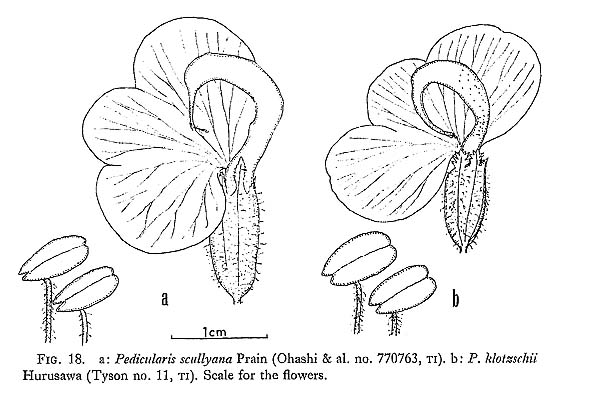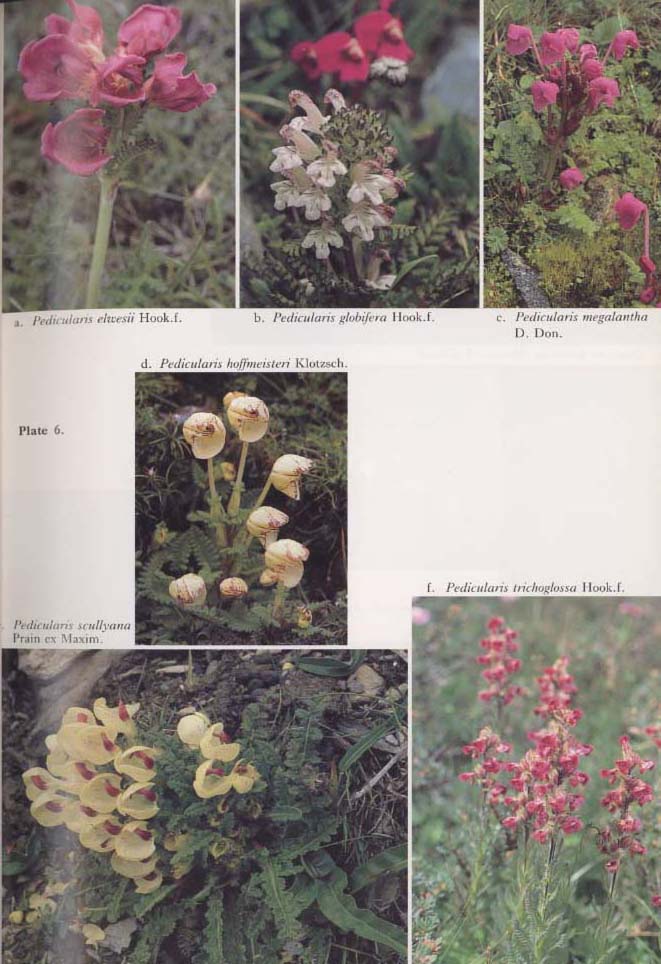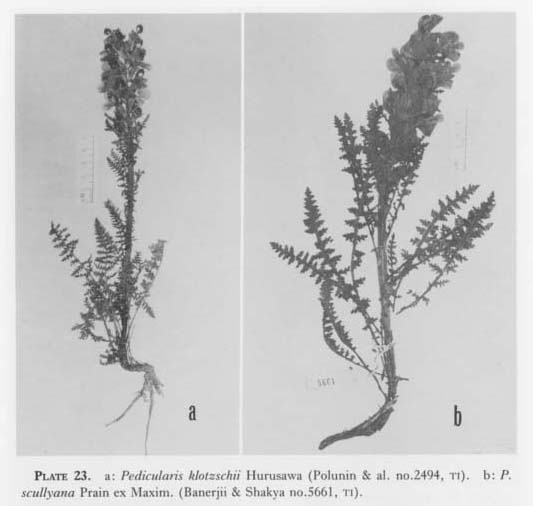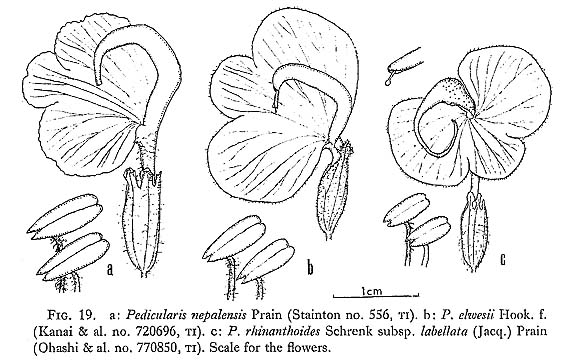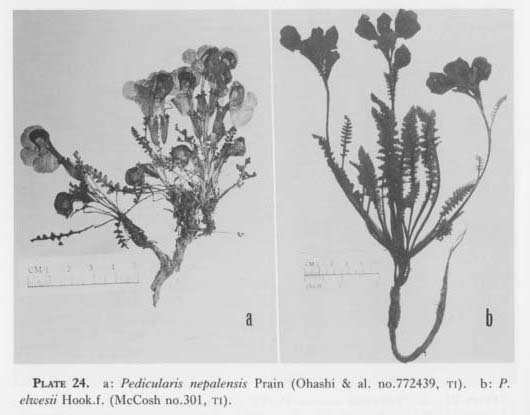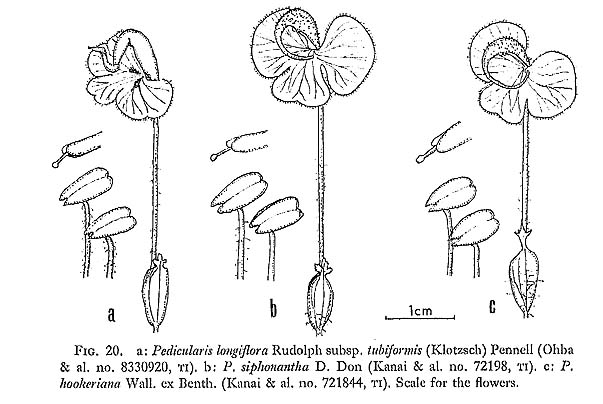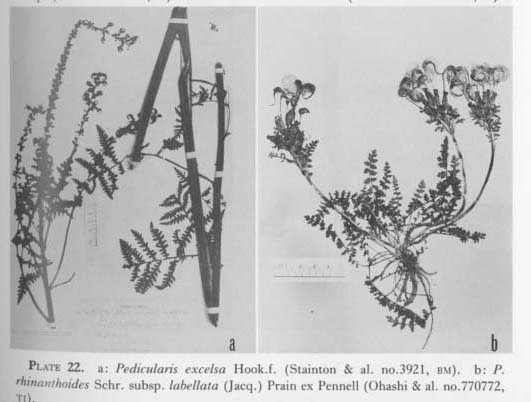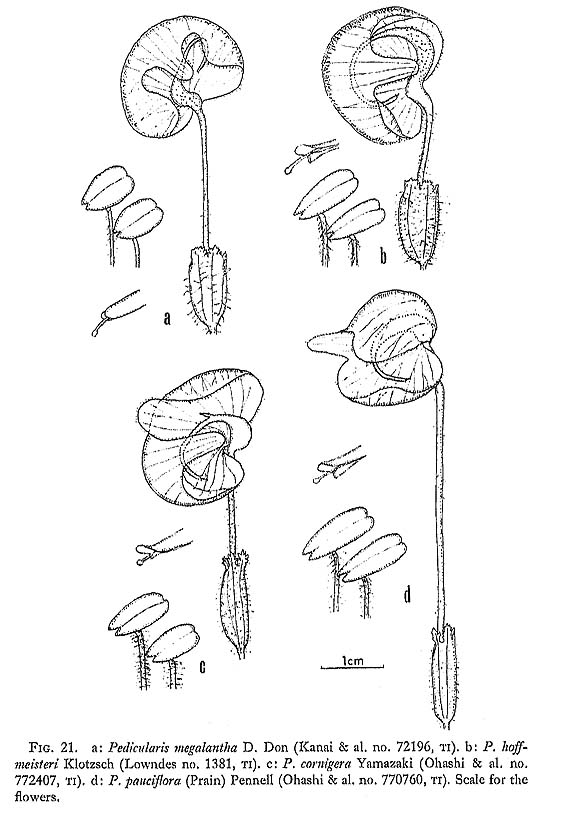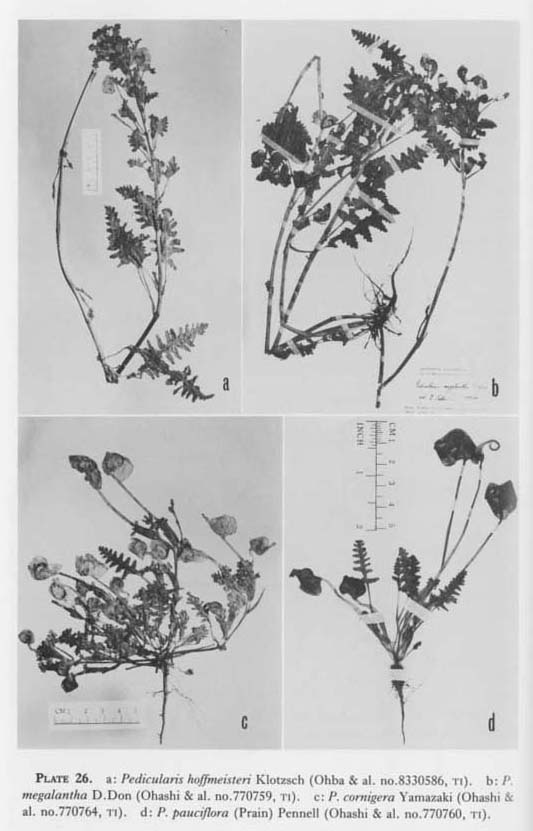A REVISION OF THE GENUS PEDICULARIS IN NEPAL
Takasi YAMAZAKI
| ( 4 / 4 ) |
Sect. 16. Phanerantha Li in Proc. Acad. Nat. Sci. Philad. 101: 143 (1949).Ser. 29. Macranthae Pram in Ann. Bot. Gard. Calcutta 3; 69 (1890), p.p.; Li in Proc. Acad. Nat. Sci. Philad. 101: 143 (1949), p.p.; Tsoong in Fl. Reip. Pop. Sin. 68:349(1963).52. Pedicularis scullyana Prain ex Maxim. [Colour Plate 6e, Plate 23b, Fig. 18a]
Prain ex Maxim, in Bull. Acad. Sci. St.-Pet. 32: 529, f. 6 (1888); Prain in Ann, Bot. Gard. Calcutta 3: 127, t. 9A-C (1980); Yamazaki in Hara & al,, Enum. Fl. Pl, Nepal 3: 125 (1982). Perennial herbs 10-60 cm tall. Roots thick, fleshy, straight. Stems branched at base, stout 2-10 mm diam., erect, simple, glabrous to lanate. Leaves alternate; petioles 1-10 cm long, the lower ones long gradually shorter upward, glabrous or pilose on the upper surfaces; blades linear to linear-lanceolate, acute at apex, 3-16 cm long 0.3-3 cm wide, glabrous or pubescent upper, white-scurfy beneath, pinnatipartite, the rachis winged, the segments 10-16-paired, frequently alternate, lanceolate-oblong, acute at apex, deeply lobed, the lobes acute at apex, mucronate-dentate. Racemes terminal, with many flowers. Bracts leaf-like, petioles broad with sparse long ciliate hairs, as long as or longer than the calyx. Pedicels 2-10 mm long, sparsely long-ciliate. Calyx urceolatetubular, 15-20 mm long 7-8 mm wide, sparsely long-ciliate, ventral part shortly split down, mouth 5-lobed, the posterior lobe small, the lateral lobes oblanceolate-oblong, acute at apex, 3-4 mm long 1-2 mm wide, entire below, acute-serrate above. Corolla pale yellow with pale purple tipped galea, 3-3.5 cm long; tube straight, 1.5-2 cm long 3 mm wide, as long as the calyx; galea sickle-shaped, the erect part c. 8 mm long, the hood c. 4 mm wide, glandular-punctate under the microscope, the beak incurved c. 5 mm long, acute and bilobed at apex, lower lip c. 18 mm long 25-30 mm wide, glabrous on the margins, 3-lobed, the middle lobe broadly orbicular, c. 8 mm long 10 mm wide, the lateral lobes broadly orbicular, c. 10mm long 15 mm wide enclosing the galea in flowering. Staminal filaments all pilose. Anthers oblong, c. 3 mm long 1.2 mm wide, the cells subacute at base. Capsule obliquely lanceolate, 20-25 mm long 6 mm wide. Distribution: Himalayas from W Nepal to Sikkim. Specimens examined: W NEPAL; Rara - huchemara Mugu dist., 3800m (Tabata & al. 1983, no. 20523, KYO), Giri Dahra, S of Jumla, 11,000 ft. (Polunin & al. 1952, no. 4778, GM, TI), Chakur Lagna, 13,000 ft. (Polunin & al. 1952, no. 421, BM, TI), Phoksund Khola, 12,000 ft. (Shrcsta 1966, no. 5354, TI), E of Chalike Pahar, 12,500 ft. (Stainton & al, 1954, HM), Tukcha, Kali Gandaki, 12,000ft. (Stainton & al. 1954, no. 7780, BM, TI), Khangsar, 16,500ft. (Lowndus 1950, no. 1285, BM), Muktinath, 13,000 ft. (Stainton & al. 1954, no. 2065, BM, TI), Purba-Puphal Dalia, Baglung dist., 4100 m (Tabata & al. 1976, no. 3677, KYO, TI). C NEPAL; Seti Khola, Annapurnn Himal, 14,500 ft. (Stainton & al. 1954, no. 6595, BM, TI), Junakpur zone, Tharc Ofr-Phedi Kharka, 4200 m (Oliba & al. 1985, no.8530515, TI), Safiarmatha zone, Beni Kharka, 4000 m (Ohha & al. 1985, no. 8531208, TI), Jargon Khola, 15,000 ft. (Lowndes 1950, no. 1285, MM), Bimtakothi, 12,500ft. (Lowndes 1950, no. 1441, DM), Rambrong, Lamjung Himal, 14,000 ft. (Stainton & al. 1954, no. 3440, BM, TI), Gosainkund, 4200 m (Kanai & al. 1969, no. 67902, TI), Gotiana, Goaainkund, 3300 m (Kanni & Malla 1969, no. 674820, TI), Kyang, Langtanp valley, 3800 m (Kanai & Shakya 1970, no. 229, TI), Rolwaling, 15,500 ft, (Stainton 1964, no. 4740, HM), Na-Khahun, Rolwaling Khola, 4000-4400 m (Ohba & al. 1983, no. 8351321, TI), Rate, 15,000 ft. (Shresta 8c Joshi 1971, no, 4511, BM), E NEPAL; Arun-Tamur, S of Topke Gola, 13,000 ft. (Stainton 1956, no, 908, HM, TI), Topke Gola-Jalanff Chliyongo, 3700 M (Kanai & al. 1972, nos. 721601, 720616, TI), Thudam-Lamni Nama, 4000 m (Ohashi & al. 1977, no. 770763, TI). 53. Pedicularis lilotzschii Hurusawa [Plate 23a, Fig. 18b] Hurusawa in J. Jap. Bot. 22: 184 (1948); Tsoong in Bull. Brit. Mus. (Nat. Hiat.) Bot. 2; 33 (1955); Yamanaki in Hara & al., Enum. Fl. Pl. Nepal 3: 123 (1982). Pedicularis macrantha Klotitsch in Klotazch et Garke, Bot. Ergebn. Reis. Waleni. 108, t. 59 (1862), not seen; Hook. f. in Fl. Brit. Ind. 4: 311 (1884); Prain in Ann. Bot. Gard. Calcutta 3: 125 t, 7A-D (1890), incl. var. hl.tescens Prain.; Pennell in Monogr. Acad. Nat. Sci. Philad. S: 147 (1943), incl. f. ochroleuca (Duthie) Prain, non Sprcngd. (1827). Perennial herbs 10-60 cm tall. Roots several, fleshy, elongate-fusiform. Stems stout, erect, simple, glabrous or pubescent. Leaves alternate, generally cauline; petioles 1-10 cm long, the lower ones long gradually shorter upward, glabrous or pubescent on the upper surfaces; blades linear to linear-lanceolate, acute at apex, 2-24 cm long 0.5-3 cm wide, sparsely white-scurfy on both surfaces, pubescent on the nerves above, pinnatisect, the pinnae 10-20-paired, opposite sometimes alternate, lanceolate-oblong to oblong-ovate, acute at apex, pinnatilobed, the lobes acute callous reflexed. Racemes terminal with lax to dense many flowers, 4-20 cm long 3 cm wide in flowering. Bracts leaf-like, small, as long as or longer than the calyx. Pedicels 2-10 mm long, pubescent. Calyx urceolate-tubular, 10-12 mm long 4-5 mm wide, sparsely to densely lanate, ventral part split about 1/3 way down, mouth 5-lobed, the posterior lobe oblong, c. 2.5 mm long 2 mm wide, incised-serrate, the lateral lobes ovate or orbicular-ovate, 4-5 mm long 3 mm wide, deeply acute-serrate. Corolla cream yellow, with the galea purple (rarely whole yellow with the throat reddish violet), 2-2.5 cm long; tube straight, 1 cm long 3 mm wide, subequaling or shorter than the calyx; galea sickle-shaped, the hood 3-4 mm wide, glabrous or sparsely pilose, the beak incurved, c. 6 mm long, acute and bilobed at apex; lower lip large, c. 10 mm long 15 mm wide, glabrous on the margins, 3-lobed, the middle lobe broadly orbicular, 6-7 mm long 7-8 mm wide, the lateral lobes orbicular, 8-10 mm long and wide. Staminal filaments all villose. Anthers elliptical, c. 3 mm long 1.5 mm wide, the cells obtuse at base. Distribution: Himalayas from Garhwal to C Nepal. Specimens examined: W NEPAL; Api Khola, 12,000 ft. (Tyson 1950, no, 11, BM, TI), Churchi Langa, 11,500 ft. (Polunin & al. 1952 no. 4341, BM, TI), Babaria Lekh, 13,000 ft. (Polunin & al, 1952, no. 79, BM, TI), Khaptnag, Mugu Khola, 15,000 ft, (Polunin & al. 1952, no. 2494, BM, TI), Tilisha, Mugu dist. 82°35' E, 29°35' N, 4200 m (R. Jackson 1984, no. 25800, KYO), Sirani-shonda-Mugu, 3160 m (Tabata & al. 1983, no. 17465, KYO), Rara, Mugu dist., 3000 m (Tabata & al. 1983, nos. 12807, 13267, 15051, 15304, KYO), Durpa, Humla Karnali, 11,000 ft. (Polunin & al, 1952, no. 4307, BM, TI), Maharigaon, Lekh, 12,000 ft. (Shresta 1966, no. 5116, BM, TI), Jumla, 82°10' E, 29°20' N, 7,500 ft. (Stainton 1966, no. 5419, BM, TI). C NEPAL; near Phagur Dhuri, 10,500 ft. (Stainton & al. 1954, no. 3406, BM, TI). Ser. 30. Robustae Prain in Ann. Bot. Gard. Calcutta 3: 69 (1890); Tsoong in Fl. Reip.Pop. Sin. 68: 347 (1963).54. Pedicularis nepalensis Prain [Plate 24a, Fig. 19a]
Prain in J. As. Soc. Bengal 58: 268 (1889), in Ann. Bot. Gard. Calcutta 3: 124, t. 6E, f, 14-20 (1890); Limpricht in Fedde, Rep. Sp. Nov. Veget. 20: 257 (1924); Tsoong in Bull. Brit. Mus. (Nat. Hist.) Bot. 2: 33 (1955); Yamazaki in Ham & al., Enum. Fl. Pl. Nepal 3: 124(1982). Perennial herbs 5-18 cm tall. Root thick, straight, fleshy, sparsely branched, the crown covered by withered petioles. Stems 1-5 cm long, sparsely pilose. Leaves alternate, mostly radical, clustered; petioles 1-4 cm long, gradually shorter toward the apex, shortly pubescent on the upper and glabrous on the under surfaces; blades linear to broadly linear, 1-10 cm long 4-20 mm wide, obtuse at apex, sparsely white-pilose on upper surface, white-scurfy beneath, pinnatipartite to pinnatisect, the pinnae 5-15-paired, ovate, acute-serrate, reflexed at the margins. Inflorescences in terminal racemes with many flowers or lower solitary in axil and upper in few flowered racemes. Bracts leaf-like, subequaling the calyx. Pedicels 7-20 mm long, sparsely pubescent. Calyx tubular or tubular-campanulate, 10-13 mm long 4-5 mm wide, sparsely long-ciliate, deeply cleft anteriorly, 5-lobed, the posterior lobe oblanceolate, small, the lateral lobes obovate or obovate-orbicular, c. 2mm long 1.5-2 mm wide, acutely incised-serrate, reflexed at the margins. Corolla purple, 2.5-3 cm long; tube 15-20 mm long 2-3 mm wide, 1.5-2 times as long as the calyx, glabrous or pilose; galea hookedly decurved, glabrous, the erect part 6-7 mm long, the turgid part c. 3 mm wide, gradually narrowing into a beak, the beak c. 5 mm long, obtuse and deeply bilobed at apex; lower lip large, c. 12 mm long 20 mm wide, undulate and glabrous on the margins, 3-lobed, the middle lobe broadly orbicular, 6-8 mm long 9-10 mm wide, the lateral lobes reniform, 12-13 mm wide. Stamens; 2 anterior filaments densely pilose, 2 posterior ones sparsely pilose, the cells acute at base. Distribution: C Nepal to Bhutan. Specimens examined: C NEPAL; Chilime Kharkti, 13,500 ft. (Polunin 1949, no, 1141, BM), Phedi-Thanti, Mangbhot distr., 4100-4400 m (Ohba & al. 1983, no. 8330863, TI), Luri, 4500 m (Lyon 1974, no. 132, TI). E NEPAL; Arun valley, Barum Khola, N of Num, 11,000 ft. (Stainton 1956, no. 556, BM, TI), Lamni Nama, 4100 m (Ohashi & al. 1977, no. 770769, TI), the same, 4300 m (Ohashi & al. 1977, no. 772436, TI), Nup-Yangma, Taplejung dist., 3900-4000 m (Tabata & al. 1978, no. 11739, KYO, TI), Pinchi Pokhari, 14-15,000 ft. (Dhwoji 1930, no.551, BM). 55. Pedicularis elwesii Hook. f. [Colour Plate 6a, Plate 24b, Fig. 19b] Hook. f. in Fl. Brit, Ind, 4: 312 (1884); Maxim. in Bull. Acad, Sci. St.-Pét. 32:532, f.8 (1888); Prain in Ann. Bot. Gard. Calcutta 3: 127, t, 8A, f.1-12 (1890); Marqand & Shaw in J. Linn. Soc. Bot. 48: 212 (1929); Li in Proc. Acad. Nat. Sci. Philad. 101:144, f. 192 (1949); Tsoongin Fl. Reip. Pop. Sin. 68: 323, t. 73,1-3 (1963); Yamazaki in Hara & al., Enum. Fl. Pl. Nepal 3: 122 (1982). Perennial herbs 5-20 cm tall. Root thick, fleshy, straight, several-branched. Stems simple or sparsely branched, ascending, densely pubescent. Leaves alternate, mostly radical clustered; petioles stout, 1-5 cm long, densely puberulous; blades chartaceous, linear, 4-11 cm long 1-1.5 cm wide, acute at apex, puberulous on both surfaces, pinnatifid, the segments 8-18-paired, oblong to ovate-oblong, obtuse at apex, crenate-serrate. Racemes short, terminal on long scapes. Bracts leaf-like, small with broad petioles, longer than the calyx. Pedicels 1-10 mm long, densely puberulous. Calyx tubular, 10-12 mm long 3-4 mm wide, ventral part split 1/4 way down, mouth 2-lobed, the lobes ovate, acute at apex, incised-serrate, 3-4 mm long 2-3 mm wide. Corolla rose purple, c. 2 cm long; tube straight below slightly curved above, c. 10 mm long 2.5 mm wide, subequaling the calyx; galea decurved and twisted near the middle, the erect part c- 3 mm long, the turgid part c. 8 mm long 2 mm wide, suddenly contracted into an incurved beak, the beak c. 4 mm long twisted, acute and deeply bilobed at apex; lower lip enclosing the galea, c. 18 mm long 22 mm wide, ciliated on the margins, 3-lobed, the middle lobe broadly orbicular, c. 6 mm long 7 mm wide, the lateral lobes reniform, c. 9 mm wide. Staminal filaments all villose. Anthers oblong, c. 3.5 mm long 1.2 mm wide, the cells acute at base. Capsule obliquely oblong, acute at apex, 15-17 mm long 5-6 mm wide. Distribution: Himalayas from Nepal to Bhutan and SE Tibet. Specimens examined: C NEPAL; Brangechen Khola, 15,000 ft. (Polunin 1949, no. 286, BM, TI), Phedi-Thanti, Gandaki zone, 4000-4400 m (Ohba & al. 1983, no. 8330903, TI), Rolwaling, 15,000 ft. (Stainton 1964, no. 4713, BM), Na-Rinaldung, Rolwaling Khola, 4000-4300 m al. 1983, no. 8331856, TI), Tchaple Himal, 4400 m (Nakao 1954, s.n., KYO, TI). E NEPAL; (Ohba & Inukhu Khola, 86°45' E, 27°30' N, 12,000 ft. (McCosh 1964, no. 301, BM, TI), Tsola Khola, Chumbo (Khumbu), 15,800 ft. (Lyon 1964, no. 2093, BM), Thudam-Lama Chungbu, 4500 m (Kanai & al. 1972, no. 720696, TI), Lamni Nama-Phujeng. 4300 m (Ohashi & al. 1977, nos. 772449, 770846, TI), Tamur valley, Yangma Khola, NE of Walungchung Gola (Stainton 1956, no. 1112, BM). Ser. 31. Longiflorae Prain in Ann. Bot. Gard. Calcutta 3: 67 (1890); Li in Proc. Acad. Nat. Sci. Philad. 101: 182 (1949); Tsoong in Fl. Reip. Pop. Sin. 68: 355 (1963).56. Pedicularis longiflora Rudolph subsp. tubiformis (Klotzsch) Pennell [Plate 25b, Fig. 20a]
Pennell in Monogr. Acad. Nat. Sci. Philad. 5: 150 (1943); Li in Proc. Acad. Nat. Sci. Philad. 101: 190 (1949). Pedicularis tubiformis Klotzsch ex Klotzsch et Garke, Bot. Erbeg. REise Waldermar 106, f. 57 (1864), not seen. Perennial herbs 6-25 cm tall. Roots several, fleshy, elongate-fusiform. Stems branched at base, simple, erect or ascending, glabrous. Leaves alternate, sometimes subopposite upper, chartaceous; petioles 1-4 cm long, glabrous or sparsely to subdensely pilose on the margins; blades linear, 1-4 cm long 3-10 mm wide, glabrous, pinnatifid, the seg ments 6-10-paired, ovate or ovate-oblong, acute at apex, doubly callous-serrate, Flowers solitary-axillary or in terminal racemes on the scapes. Bracts leaf-like, with broad petioles. Pedicles 2-15 mm long, glabrous. Calyx urceolate-tubular, 8-10mm long 4-5 mm wide, membranous, glabrous or sparsely long-pilose, ventral part split about 1/2 way down, mouth, 2-lobed, the lobes ovate stipitate, generally trifid, the lobules acute-dentate. Corolla yellow, with two red spots on the lower lip; tube slender, 3-5 cm long 1.5 mm wide, 3-5 times as long as the calyx; galea very twisted, glabrous, the hood 2,5 mm wide, gradually narrowing into a slender beak, the beak c, 5 mm long, acute and shallowly bilobed at apex; lower lip 6-8 mm long 15-17 mm wide, pilose on the margins, 3-lobed, the middle lobes broadly orbicular, emarginate, c, 5mm long 6mm wide, the lateral lobes reniform, c. 8 mm wide. Staminal filaments all pilose. Anthers oblong, c. 2 mm long 1 mm wide, the cells acute at base. Capsule lanceolate-oblong, acuminate at apex, 13-17 mm long 4-5 mm wide. Distribution: Himalayas from Baltistan to Bhutan, W and E Tibet and W China. Specimens examined; W NEPAL; Siranishonda-Mugu, 3300 m (Tabata & al. 1983, no. 17476, KYO). C NEPAL; Thinigaon, N of Tukucha, 12,500 ft. (Stainton & al. 1954, no. 8428, BM, TI), Tukucha, Kali Gandaki, 8,500 ft. (Stainton & al. 1954, no. 1071, BM), Namdo, N of Mustang, 17,000ft. (Stainton & al. 1954, no. 2283, BM), Chakar-Muktinath, 11,000 ft. (Tabata & al. 1976, no. 6344, KYO, TI), Jharkot-Muktinath, 3400 m (Ohba & al. 1983, no. 8310612, TI), Tanti-Manangbhot dist., 3500-4000 m (Ohba & al. 1983, no. 8330920, TI), Chum Gompa, 3600 m (Nakao 1953, s.n., KYO, TI), Langtang Himal, 12,500 ft. (Stainton 1962, no. 4077, BM), Kyanging, Langtang Khola, 3600 m (Kanai & Shakya 1970, no. 672520, TI), Thami Khumbu, 14,000 ft. (Schilling 1966, no. 984, BM, TI). E NEPAL; Sagarmatha zone, Thosa Kharka-Beni Kharka, 3600-4300 m (Ohba & al. 1985, no. 8581088, TI), Khumbu, Langmoche Khola, 13,800 ft. (Lyon 1964, no. 2181, BM, TI), Chodo Gyabo-Topke Gola, 3900 m (Ohashi & al. 1977, no. 770871, TI), Chini-Nup, Taplejung dist., 3800 m (Tabata & al. 1978, no. 11638, KYO, TI). 57. Pedicularis hookeriana Wall. ex Benth. [Plate 25a, Fig. 20c] Benth., Scroph. Ind. 53 (1935), in DC., Prodr. 10: 564 (1846); Pennell in Monogr. Acad. Nat. Sci. Philad. 5: 155 (1943); Yamazaki in Hara & al., Enum. Fl. Pl. Nepal 3: 123 (1982). Pedicularis himalaica Klotzsch ex Klotzsch et Garcke, Bot. Ergebn. Reise Waldermar 107, t. 58 (1862), not seen. Annual herbs 15-40 cm tall. Root straight, simple or sparsely branched. Stems laxly branched, glabrous. Leaves alternate, sometimes subopposite above; petioles slender 2-5 cm long, glabrous or sparsely pilose; blades lanceolate or oblong-lanceolate, 1.5-7 cm long 1-3 cm wide, glabrous rarely sparsely pilose on both surfaces, distantly pinnatisect, rachis not winged or obscurely narrow-winged, the pinnae 3-9-paired, oblong-lanceolate, acute at apex, aristately acute-serrate. Flowers generally in terminal heads, sometimes solitary-axillary. Pedicels 1-4 (-10) mm long. Calyx membranous, urceolate-tubular, 10-12 mm long 3-4 mm wide, glabrous or sparsely pilose, ventral part split about 1/3 way down, mouth 2-lobed, the lobes ovate, stipitate, acuminately incised-serrate. Corolla bright-pink, with whitish tube and lower lip; tube straight, 3.5-4.5 cm long 1-1.5 mm wide, 4-5 times as long as the calyx, sparsely pilose; galea twisted annular, the hood c, 2 mm wide, with a projection on each ventral margin, glandular-punctate under the microscope, gradually narrowing into a slender beak, the beak c. 8 mm long, acute and shallowly bilobed at apex; lower lip large, c. 10 mm long 20 mm wide, pilose on the margins, deeply 3-lobed, the middle lobe obcordate, emarginate, c. 6mm long 8 mm wide, the lateral lobes renifbrm, c. 6mm long 10 mm wide. Staminal filaments all glabrous. Anthers narrowly elliptical, c. 2 mm long 1 mm wide, the cells acute at base. Capsule obliquely lanceolate-oblong, acuminate at apex, 13-15 mm long 4 mm wide, about 2 times as long as the calyx. Distribution: Himalayas from Simla to C Nepal. Specimens examined: W NEPAL; Two miles E of Saipal, 16,000 ft. (Arnold 1954, no. 293, BM), Munya Lagna-Palsa, Humla dist., 3500 m (Tabata & al. 1983, no, 24272, KYO), near Balangra pass, 12,500 ft. (Polunin & al. 1952, no. 2550, BM). C NEPAL; Chumji, Seti Khola, 10,500 ft. (Gardner 1953, no. 868, BM), Seti Khola, Annapurna Himal, 11,500 ft. (Stainton & al. 1954, no. 6528, BM), Rambtong, Lamjung Himal, 11,500 ft (Stainton & al. 1954, no. 5995, BM), Singum Gompa, Gosainkund, 3600 m (Kanai & al. 1972, no. 721844, TI). 58. Pedicularis siphonantha D. Don [Plate 25c, Fig. 20b] D. Don, Prod. Fl. Nepal. 95 (1825); Bentham in DC., Prod. 10: 565 (1846); Hook. f. in Fl. Brit. Ind. 4: 313 (1884), excl. syn.; Maxim. in Bull. Acad. Sci. St.-Pét. 32: 534 (1888); Prain in Ann. Bot. Gard. Calcutta 3: 113, t. 2A, B (1890); Limpricht in Fedde, Rep. Sp. Nov. Veget. 20: 251 (1924), p.p.; Tsoong in Fl. Reip. Pop. Sin. 68: 373, t. 87, 4-6 (1963); Yamazaki in Hara & al., Enum. Fl. Pl. Nepal 3: 125 (1982). Pedicularis tsoongii Yamazaki in J. Jap. Bot. 45: 174, f. 21 (1971), in Hara & al., Enum. Fl. Pl. Nepal 3: 125 (1982), syn. nov. Annual herbs 5-20 cm long. Root straight, simple or sparsely branched. Stems many branched at base, clustered, simple, erect or ascending, sometimes prostrate, glabrous or pubescent. Leaves membranous, alternate, mostly radical; petioles 1-4 cm long, glabrous or long-pilose; blades linear-oblong, 1-4 cm long 2-15 mm wide, glabrous or sparsely pilose above, callously reticulated and sparsely pilose beneath, pinnatisect, rachis narrowly winged, the pinnae 5-8-paired, ovate or ovate-oblong, doubly acute-serrate. Flowers solitary-axillary on the upper stems; pedicels 2-5 mm long, glabrous or pilose. Calyx membranous, urceolate-tubular, 10-12 mm long 3 mm wide, sparsely pilose, ventral part split about 1/3 way down, mouth 2-lobed, the lobes orbicular, shortly stipitate, 2-3 mm long and wide, doubly incised-serrate. Corolla rose-purple with the throat white, rarely white all over, 4-10 cm long; tube straight, 3-9 cm long 1-1.5 mm wide, 4-10 times as long as the calyx, pilose; galea twisted annular, the hood c. 2 mm wide, with a projection on each ventral margin, glandular-punctate under the microscope, gradually narrowing into a slender beak, the beak c. 10mm long, acute and shallowly bilobed at apex; lower lip large, 8-10 mm long 15-18 mm wide, pilose on the margins, deeply 3-lobcd, the middle lobe obcordate, emarginate, c. 6 mm long 7 mm wide, the lateral lobes reniform, c. 6 mm long 10 mm wide. Stamens; 2 anterior filaments sparsely pilose, 2 posterior ones glabrous; anthers narrowly elliptical, c. 2 mm long 1 mm wide, the cells subacute at base. Capsule lanceolate-oblong, 10-15 mm long 4-5 mm wide, about 2 times as long as the calyx. Distribution: Himalayas from W Nepal to Bhutan and SE Tibet. Specimens examined: W NEPAL; Munya Langna-Palsa, Humla diat., 3500 m (Tabata & al, 1983, no. 24271, KYO), Kangsa-Chhongya, Mugu diat., 4150 m (Tabata & al. 1983, no. 22652, KYO), Mabu Lagna, Kallikot dist., 3470 m (Tabata & al., no. 19284, KYO), near Balangra pass, 12,500 ft. (Polunin 1952, no, 2557, Type of P. tsoongii, BM). C NEPAL; Dipinada-Dhorpatan. Balang dist., 3700-3800 m (Tabata & al. 1976, no. 3843, KYO, TI), Jarglung Khola, 14,500 ft, (Lowndea 1950, no. 1325, BM, TI), Muktinath-Phedi, 4000 m (Ohba & al. 1983. no. 8310662, TI), Phedi-Thanti, Manangbhot dist., 4000-4400 m (Ohba & al. 1983, no. 8350696, TI), Tse dang Pokhari, 3000 m (Kanai & Malla 1969, no. 67667, TI), Maney Dara, 13-14,000 ft. (Dhowoj 1930, no. 508, BM), Langtang-Kyaging, 3800 m (Kanai & al. 1970, no. 670475, TI), Mogar-cheko Danda, 4300 m (Kanai & al. 1970, no. 2994, TI), Inkhu Khola, 12,000 ft. (McCosh 1964, no. 300, BM), Beding-Na, Rolwaling Khola, 3600-4000 m (Ohba & al. 1983, no. 8331810, TI). E NEPAL; Janakpur zone, Chhu Ningma-Jata Pokharu, 4000-4200 m (Ohba & al. 1985, no. 8539278, TI), Thare Og-Phedi Kharka, 4150 m (Ohba & al. 1985, no. 8530513, TI), Lunding Khola-Raule, 86°30' E 27°30' N, 14,000 ft. (McCosh 1964, no. 413, BM, TI), Sagaematha zone, Tosa Kharka-Beni Kharka, 3600-4300 m (Ohba & al. 1985, no. 8581077, TI), Thudam, 4000 m (Tabata & al. 1978, no. 1461, KYO, TI), Thudam-Lamni Nama, 3900 m (Ohashi & al. 1977, no. 770762, TI), Topke Gola, 3600 m (Kanai & al. 1972, no. 72198, TI), Saju Pokhari, 4200 m (Kanai & al. 1972, no. 1557, TI). Note: P. tsoongii is probably the same with P. siphonantha var, prostrata Bonati ex W. W. Smith (Rec. Bot. Surv. Ind. 4: 400, 1913) or P. siphonantha subsp. prostrata (Bonati ex W. W. Smith) Tsoong (Act. Phytotax. Sin. 3: 319, 1955). They seem to be an ecological form of P. siphonantha. Sect. 17. Botryantha Li in Proc. Acad. Nat. Sci. Philad. 101: 115 (1949).Ser. 32. Rhinanthoises Prain in Ann. Bot, Gard. Calcutta 3: 67 (1890), p.p.; Li in Proc. Acad. Nat. Sci. Philad. 101: 124 (1949); Tsoong in Fl. Reip. Pop. Sin. 68: 261 (1963).59. Pedicularis rhinanthoides Schrenk subsp. labellata (Jacq.) Prain ex Pennell [Plate 22b, Fig. 19c]
Pennell in Monogr. Acad. Nat. Sci. Philad. 5: 152 (1943); Tsoong in Fl. Reip. Pop. Sin. 68: 263, t.59, 1-4 (1963); Yamazaki in Hara & al., Enum. Fl. Pl. Nepal 3: 125 (1982). Pedicularis labellata Jacquem., Voy. 4 (Bot.): 123 (1835). Perennial herbs 10-20 cm tall. Roots several, elongate-fusiform, descending from the crown. Stems branched at base, simple, ascending, glabrous. Leaves alternate, mostly radical, cauline ones few; petioles 1-4 cm long, glabrous or sparsely pubescent; blades linear to linear-lanceolate, acute at apex, 1.5-7 cm long 5-15 mm wide, glabrous or sparsely pubescent on both surfaces, pinnatisect, the pinnae ovate or oblong-ovate, acute at apex, doubly incised-serrate. Inflorescences in terminal racemes on the scapes, short, with 3-10 flowers. Bracts leaf-like, small, sparsely white-pilose, petioles short and broad, blades ovate to deltoid-ovate, as long as or shorter than the calyx. Pedicels 1-5 mm long, sparsely white-pilose. Calyx urceolate-tubular, membranous, 10-13 mm long 4-5 mm wide, sparsely white-pilose, ventral part split 1/2 to 2/3 way down, mouth 5-lobed, the posterior lobe lanceolate acute at apex entire, the lateral lobes obovate oblong, 2-3 mm long 1 mm wide, entire below acute-serrate above. Corolla red-purple, 2.5-3.5 cm long; tube straight, 2-3 cm long 1.5 mm wide, 2-2.5 times as long as the calyx, glabrous; galea twisted annular, the hood 4 mm wide, with a tooth on each ventral margin, glandular-punctate under the microscope, gradually narrowing up ward and produced into a slender beak, the beak c. 15 mm long, acute and shallowly bilobed at apex; lower lip large, enclosing the galea, c. 15mm long 25 mm wide, pilose on the margins, 3-lobed, the middle lobe broadly orbicular, c. 6 mm long 10 mm wide, the lateral lobes reniform c. 15 mm wide. Stamens; 2 anterior filaments villose, 2 posterior ones glabrous; anthers oblong, c. 2.5 mm long 1.3 mm wide, the cells acute at base. Distribution: Himalayas from Gilgit to Bhutan, and SE Tibet and W China. Specimens examined: W NEPAL; Tangkhaya-Teungoya, Mugu dist., 3840 m (Tabata & al. 1983. no. 17683, KYO), Thahurji Lekh, S of Jumla, 12,000 ft. (Polunin & al. 1951, no. 4729, BM). C NEPAL; Khangsar, 16,000 ft. (Lowndes 1950, no. 1281, BM), Tegar, N of Mustang, 15,000 ft. (Stainton & al. 1954, no. 2229, BM). E NEPAL; Lamni Nama-Phujeng, 4,000 m (Ohashi & al. 1977, no. 770850, TI), Thudam-Laimni Nama, 4000 m (Ohashi & al. 1977, no. 770772, TI), Thudam-Khang La, 3355 m (Tabata & al. 1978, no. 7577, KYO, TI). Sect. 18. Saccochilus Yamazaki, sect. nov.Corolla; tubus elongatus, calyce 2-6-plo longior; labium inferum saccatum, galeam obtectum, lobo medio parvo ligulato. Typus: Pedicularis megalantha D. Don. Ser. 33. Megalanthae Prain m Ann. Bot. Gard. Calcutta 3: 68 (1890); Tsoong in Fl. Reip. Pop. Sin. 68: 375 (1963).60. Pedicularis hoffmeisteri Klotzsch [Colour Plate 6d, Plate 26a, Fig. 21b]
Klotzsch et Garke, Bot. Ergeb. Reise Waldermar 108, t. 60 (1862), not seen; Pennell in Monogr. Acad. Nat. Sci. Philad. 5: 147 (1943); Yamazaki in Kihara ed., Fa. and Fl. Nepal Himal. 220 (1955), in Hara & al., Enum. Fl. Pl. Nepal 3: 123 (1982). Pedicularis megalantha (auct. non D. Don: Regel in Gartenfl. 27: 195, t.943 (1878); Prain in Ann. Bot. Gard. Calcutta 3: 118, t.4B, C (1890). Annual herbs 15-70 cm tall. Root straight, simple or sparsely branched. Stems not or sparsely branched at base, simple, sparsely to subdensely pilose. Leaves alternate; perioles 2-7 cm long, white-pilose; blades lanceolate or linear-lanceolate, 2-7 cm long 1-3 cm wide, subacute at apex, sparsely white-pilose, pinnatilobed or pinnatified, the segments oblong-ovate pinnatilobed, the lobes acute-serrate. Flowers solitary-axillary or in terminal racemes. Bracts leaf-like, small, petioles broad subdensely white-lanate on the margins, blades ovate or deltoid-ovate, pinnatifid. Pedicels 2-8 mm long. Calyx membranous, urceolate-tubular, 13-18 mm long 5-6 mm wide, sparsely to densely white-lanate, ventral part split 1/4-1/3 way down, mouth 5-lobed, the lobes orbicular, c. 2 mm long and wide, doubly incised-dentate. Corolla lemon-yellow with the beak yellow or purplish, 3-4 cm long; tube straight slender, 2.5-3.5 cm long 1 mm wide, 2-2.5 times as long as the calyx, pilose; galea twisted annular, the hood c. 3 mm wide, glandular-punctate under the microscope, gradually narrowing upward and produced into a slender beak, the beak c. 12mm long, obliquely acute and emarginate at apex; lower lip large, enclosing the galea, c. 15 mm. long 25 mm wide, pilose on the margins, 3-lobed, the middle lobe ligular, c. 6 mm long 4 mm wide, the lateral lobes reniform, c. 15 mm wide. Staminal filaments all villose. Anthers oblong, c. 2.5 mm long 1.2 mm wide, the cells acute at base. Capsule lanceolate, acuminate at apex, 20-25 mm long 6 mm wide. Distribution: Himalayas from Chamba to C Nepal. Specimens examined: W NEPAL; Tangkhaya-Teungoya, Mugu dist., 3840 m (Tabata & al. 1983, no. 17686, KYO), Chittaikuna-Sirsnishonda, Mugu dist., 2850 m (Tabata & al. 1983, no. 17399, KYO), Chuchemara pass, Rara, Mugu dist., 3800 m (Tabata & al. 1983, no. 16644, KYO), Chankheli Lagna-Sat Thaple, Mumla dist., 3470 m (Tabata & al. 1983, no. 23357, KYO), Dhalaun-Rosia pass, Bajhang dist., 2700 m (Tabata & al. 1976, no. 1617, KYO, TI), Ghurchi Lagna, 3250 m (Shresta & Manandhar 1975, no. 179, TI), Phoksubd Khola, 12,000 ft. (Shresta 1966, no, 5354A, TI). C NEPAL; Muktinath, 12,500 ft. (Stainton & al. 1954, no. 1420, BM), Marsyandi valley, 10,000 ft. (Lowndes 1950, no. 1381, BM, TI), Humde-Bardang, Marsyandi Khola, 2850-3320 m (Ohba & al. 1983, nos. 8331162, 8350818, TI), Kalopani-Tukche, 2600 m (Ohba & al, 1983, no. 8330586, TI). 61. Pedicularis cornigera Yamazaki [Plate 26c, Fig. 21c] Yamazaki in J. Jap. Bot. 55: 293, f. 2, f. 3c-e (1980), in Hara & al., Enum. Fl. Pl. Nepal 3: 122(1982). Annual herbs 5-20 cm tall. Root straight, simple, with several fibrous rootlets. Stems branched at base, sparsely white-pilose. Leaves alternate, sometimes subopposite upper; petioles 1-4 cm long, sparsely white-pilose; blades lanceolate-oblong, 1-5 cm long 0.5-2 cm wide, white-pilose on both surfaces, pinnatifid, the segments 6-10-paired, ovate or oblong-ovate, obtuse at apex, crenate-serrate, Flowers solitary-axillary; pedicels 3-10 mm long, pubescent. Calyx membranous, 13-17 mm long 4-5 mm wide, sparsely white-lanate, ventral part split 1/2 way down, mouth 5-lobed, the posterior lobe obovate or oblanceolate-oblong, 1-2 mm long, crenate-dentate, the lateral lobes ovate or ovate-flabellate, 2-4 mm long 1.5-3 mm wide. Corolla cream-yellow, 4-6 cm long; tube slender, 3-5 cm long 1.5 mm wide, 3-4 times as long as the calyx, sparsely pilose; galea twisted annular, glabrous, the hood 3.5 mm wide, with a horn of 1 mm length on the dorsal side, gradually narrowing upward and produced into a long slender beak, the beak c. 15 mm long, obliquely acute and emarginate at apex; lower lip large, c. 18 mm long 25 mm wide, densely pilose on the margins, 3-lobed, the middle lobe ligular, 6-7 mm long 3-4 mm wide, the lateral lobes reniform, c. 15 mm wide. Staminal filaments all villose. Anthers oblong, c. 2.5 mm long 1.2 mm wide, the cells obtuae at base. Distribution: E Nepal. Specimens examined; E NEPAL; Thudam-Lamni Nama, 4000 m (Ohashi & al. 1977, no. 772407, type TI, nos. 770364, 770765, 773735, 775068, TI), Nama-Tasagon, 4300 m (Ohashi & al. 1977, nos. 772455, 770851, TI). 62. Pedicularis megalantha D. Don [Colour Plate 6c, Plate 26b, Fig. 21a] D. Don, Prod, Fl, Nepal. 94 (1825); Bentham in DC., Prodr. 10: 564 (1846), excl. spuc. of Kashmir; Hook. f. in Fl. Brit. Ind. 4: 312 (1884), excl. spec. of Kumaon, in Bot. Mag. 116: t. 7132 (1890); Maxim. in Bull. Acad. Sci. St.-Pét. 32: 532 (1888), p.p., excl. syn. and var.; Prain in Ann. Bot. Gard. Calcutta 3: 118, t.4A, f, 1-6 (1890), p.p., excl. t. 4 B, C; Pennell in Monogr. Acad. Nat. Sci. Philad. 5: 149 (1943); Tsoong in Fl. Reip. Pop. Sin. 68: 377, t. 88, 5-6 (1963); Yamazaki in Hara & al., Enum. Fl. Pl. Nepal 3: 124(1982). Annual herbs 10-80 cm tall. Root straight, simple or sparsely branched. Stems not or sparsely branched at base, simple, erect or ascending, glabrous. Leaves alternate; petioles 2-8 cm long, glabrous; blades linear-lanceolate, acute at apex, 4-12 cm long 1-4 cm wide, sparsely pilose on both surfaces, pinnatifid to pinnatipartite, the segments ovate or oblong-ovate, pinnatilobed, the lobes crenate-serrate. Flowers in terminal racemes. Bracts leaf-like, as long as or longer than the calyx, petioles short and broad, ciliate on the margins. Pedicels slender, 2-4 mm long, glabrous. Calyx membranous, urceolate-tubular, 15-20 mm long S-8 mm wide, glabrous or white-pilose, ventral part split about 1/3 way down, mouth 5-lobed, the lobes orbicular, c. 2 mm long and wide, doubly incised-dentate, the posterior one smaller. Corolla pink or red-purple, 5-7 cm long; tube straight, slender, 4-6 cm long 1 mm wide, 2.5-4 times as long as the calyx, sparsely pilose; galea twisted annular, the hood c. 3 mm wide, gladular-punctate under the microscope, gradually narrowing upward and produced into a slender beak, the beak c. 10 mm long, obliquely acute and emarginate at apex; lower lip large, enclosing the galea, pilose on the margins, 3-lobed, the middle lobe ligular, c. 7 mm long 4 mm wide, the lateral lobes broadly orbicular, c. 15 mm wide. Stamens; 2 anterior fllaments pilose, 2 posterior ones glabrous; anthers elliptical, c, 2.5 mm long 1,5 mm wide, the cells acute at base. Capsule lanceolate, apiculate-acute at apex, c. 3 cm long 8-9 mm wide, 1.5-2 times as long as the calyx. Distribution: Himalayas from C Nepal to Bhutan and SE Tibet. Specimens examined: C NEPAL; Kali Gandaki, 12,500ft. (Stainton & al. 1954, no. 7770, BM). Jarjung, S of Tukucha, 10,000 ft. (Stainton & al. 1954, no. 1193, BM), Yoti Khola, Annapurna Himal, 13,000 ft. (Stainton & al. 1954, no. 6544, BM), Langtang, 11,000 ft. (Polunin 1949, no. 527, BM), Yatumbal-Ookhatka, Langtang valley, 3400 m (Kanai & Shakya 1970, no. 670479, TI), Gotiora, Gosainkund, 3300m (Kanai & Malla 1969, no. 674781, TI), Gosainkund-Sur-jakund, 4300 m (Kanai & al. 1972, no, 72196, TI), Bisauna-Tingiang, 2800m (Kanai & al. 1970, no. 67625, TI), Khare Khola, Pam Lhang-Bitta Kharka, 4100-4300 m (Ohba & al. 1983, no. 8351404, TI), Rolwaling Khola, Kyalche-Thamdigma, 2700-3200 m (Ohba & al. 1983, no. 8351198, TI). E NEPAL; Janakpur zone, Jata Pokhari, 4200 m (Ohba & al. 1985, no. 8530357, TI), Thudam-Lamni Nama, 3200-3600 m (Ohashi & al. 1977, no. 770759, TI), Topke Gola-Chodo Gyaba, 3600-4000 m (Kanai & Tateishi 1977, no. 770941, TI). 63. Pedicularis pauciflora (Pram) Pennell[Plate 26d, Fig. 21d] Pennell in Monogr. Acad, Nat. Sci. Philad. 5: 149 (1943); Yamazaki in J. Jap. Bot. 61:301 (1986). Pedicularis megalantha D. Don var. pauciflora Prain ex Maxim. in Bull. Acad. Sci. St.-Pét. 32: 532 (1888); Prain in Ann. Bot. Gard. Calcutta 3: 118, t.4C, f.10-15 (1890); Limpricht in Fedde, Rep. Sp. Nov. Veget. 20: 253 (1924). Annual herbs 7-13 cm tall. Root straight, simple. Stems short, 2-5 cm long, glabrous or sparsely pilose. Leaves membranous, alternate, clustered near base of the stems; petioles 1-2 cm long, pubescent; blades linear-lanceolate, 1-2,5 cm long 3-10 mm wide, white-scurfy on both surfaces, pinnatifid, the segments 6-8-paired, oblong-ovate, obtuse at apex, doubly crenate-serrate. Flowers solitary-axillary, 3-8 on the short stems. Pedicels 2-3 mm long, puberule. Calyx tubular, 13-15 mm long 3 mm wide, sparsely white-pilose, ventral part split about 1/3 way down, mouth 5-lobed, the posterior lobe oblan-ceolate, c. 2 mm long 1 mm wide, entire lower, crenate-serrate upper, the lateral lobes ovate, c. 2 mm long 1.5 mm wide, crenate-serrate. Corolla purple; tube straight slender, 5-7 cm long 1.5 mm wide, 4.5-6 times as long as the calyx, sparsely pilose; galea twisted annular, the hood 4 mm wide, glandular-punctate under the microscope, gradually narrowing upward and produced into a slender beak, the beak c. 15 mm long, obliquely acute and emarginate at apex; lower lip large, enclosing the galea, c. 16mm long 25 mm wide, pilose on the margins, 3-lobed, the middle lobe ligular, c. 8mm long 5 mm wide, the lateral lobes reniform, c. 14mm wide. Staminal filaments all villose. Anthers oblong, c. 2.5 mm long 1.2 mm wide, the cells acute at base. Distribution: Himalayas from E Nepal to Bhutan. Specimens examined: E NEPAL; Sagarmatha zone, Thosa Kharka-Beni Kharka, 3600-4600 m (Ohba & al. 1985, no. 8581110, TI), Beni Kharka-Dudh Kund, 4000-4600 m (Ohba & al., 1985, no. 8572048, TI), Thudam-Lamni Nama, 3500-4200 m (Ohashi & al. 1977, no. 770760, Type of P. megalochila var. longituba, TI). |
